Interpolator的种类
Posted
tags:
篇首语:本文由小常识网(cha138.com)小编为大家整理,主要介绍了Interpolator的种类相关的知识,希望对你有一定的参考价值。
Interpolator被用来修饰动画效果,定义动画的变化率,可以使存在的动画效果accelerated(加速),decelerated(减速),repeated(重复),bounced(弹跳)等。Interpolator用于动画中的时间插值,其作用就是把0到1的浮点值变化映射到另一个浮点值变化。
1、LinearInterpolator以常量速率改变。
2、AccelerateInterpolator在动画开始的地方速率改变比较慢,然后开始加速。
3、DecelerateInterpolator在动画开始的地方快然后慢。
4、AccelerateDecelerateInterpolator在动画开始与结束的地方速率改变比较慢,在中间的时候加速。
5、AnticipateInterpolator开始的时候向后然后向前甩。
6、OvershootInterpolator向前甩一定值后再回到原来位置。
7、AnticipateOvershootInterpolator开始的时候向后然后向前甩一定值后返回最后的值。
8、BounceInterpolator动画结束的时候弹起。
9、CycleInterpolator动画循环播放特定的次数,速率改变沿着正弦曲线。
10、自定义interpolators。
LinearInterpolater
源码:
/**
* An interpolator where the rate of change is constant
*
*/
public class LinearInterpolator implements Interpolator {
public LinearInterpolator() {
}
public LinearInterpolator(Context context, AttributeSet attrs) {
}
public float getInterpolation(float input) {
return input;
}
}
曲线图:

AccelerateInterpolator
源码:
/**
* An interpolator where the rate of change starts out slowly and
* and then accelerates.
*
*/
public class AccelerateInterpolator implements Interpolator {
private final float mFactor;
private final double mDoubleFactor;
public AccelerateInterpolator() {
mFactor = 1.0f;
mDoubleFactor = 2.0;
}
/**
* Constructor
*
* @param factor Degree to which the animation should be eased. Seting
* factor to 1.0f produces a y=x^2 parabola. Increasing factor above
* 1.0f exaggerates the ease-in effect (i.e., it starts even
* slower and ends evens faster)
*/
public AccelerateInterpolator(float factor) {
mFactor = factor;
mDoubleFactor = 2 * mFactor;
}
public AccelerateInterpolator(Context context, AttributeSet attrs) {
TypedArray a =
context.obtainStyledAttributes(attrs, com.android.internal.R.styleable.AccelerateInterpolator);
mFactor = a.getFloat(com.android.internal.R.styleable.AccelerateInterpolator_factor, 1.0f);
mDoubleFactor = 2 * mFactor;
a.recycle();
}
public float getInterpolation(float input) {
if (mFactor == 1.0f) {
return input * input;
} else {
return (float)Math.pow(input, mDoubleFactor);
}
}
}
曲线图:

DecelerateInterpolator
源码:
/**
* An interpolator where the rate of change starts out quickly and
* and then decelerates.
*
*/
public class DecelerateInterpolator implements Interpolator {
public DecelerateInterpolator() {
}
/**
* Constructor
*
* @param factor Degree to which the animation should be eased. Setting factor to 1.0f produces
* an upside-down y=x^2 parabola. Increasing factor above 1.0f makes exaggerates the
* ease-out effect (i.e., it starts even faster and ends evens slower)
*/
public DecelerateInterpolator(float factor) {
mFactor = factor;
}
public DecelerateInterpolator(Context context, AttributeSet attrs) {
TypedArray a =
context.obtainStyledAttributes(attrs, com.android.internal.R.styleable.DecelerateInterpolator);
mFactor = a.getFloat(com.android.internal.R.styleable.DecelerateInterpolator_factor, 1.0f);
a.recycle();
}
public float getInterpolation(float input) {
float result;
if (mFactor == 1.0f) {
result = (float)(1.0f - (1.0f - input) * (1.0f - input));
} else {
result = (float)(1.0f - Math.pow((1.0f - input), 2 * mFactor));
}
return result;
}
private float mFactor = 1.0f;
}
曲线图:
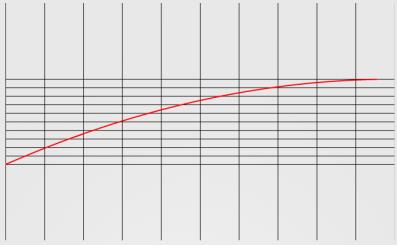
AccelerateDecelerateInterpolator
源码:
/**
* An interpolator where the rate of change starts and ends slowly but
* accelerates through the middle.
*
*/
public class AccelerateDecelerateInterpolator implements Interpolator {
public AccelerateDecelerateInterpolator() {
}
@SuppressWarnings({"UnusedDeclaration"})
public AccelerateDecelerateInterpolator(Context context, AttributeSet attrs) {
}
public float getInterpolation(float input) {
return (float)(Math.cos((input + 1) * Math.PI) / 2.0f) + 0.5f;
}
}
曲线图:
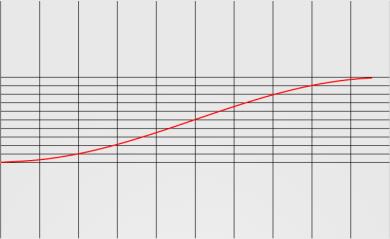
AnticipateInterpolator
源码:
/**
* An interpolator where the change starts backward then flings forward.
*/
public class AnticipateInterpolator implements Interpolator {
private final float mTension;
public AnticipateInterpolator() {
mTension = 2.0f;
}
/**
* @param tension Amount of anticipation. When tension equals 0.0f, there is
* no anticipation and the interpolator becomes a simple
* acceleration interpolator.
*/
public AnticipateInterpolator(float tension) {
mTension = tension;
}
public AnticipateInterpolator(Context context, AttributeSet attrs) {
TypedArray a = context.obtainStyledAttributes(attrs,
com.android.internal.R.styleable.AnticipateInterpolator);
mTension =
a.getFloat(com.android.internal.R.styleable.AnticipateInterpolator_tension, 2.0f);
a.recycle();
}
public float getInterpolation(float t) {
// a(t) = t * t * ((tension + 1) * t - tension)
return t * t * ((mTension + 1) * t - mTension);
}
}
曲线图:
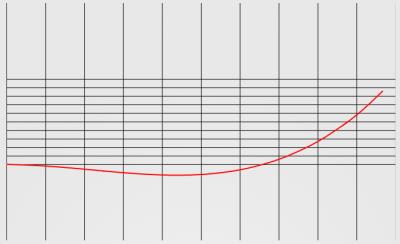
OvershootInterpolator
源码:
/**
* An interpolator where the change flings forward and overshoots the last value
* then comes back.
*/
public class OvershootInterpolator implements Interpolator {
private final float mTension;
public OvershootInterpolator() {
mTension = 2.0f;
}
/**
* @param tension Amount of overshoot. When tension equals 0.0f, there is
* no overshoot and the interpolator becomes a simple
* deceleration interpolator.
*/
public OvershootInterpolator(float tension) {
mTension = tension;
}
public OvershootInterpolator(Context context, AttributeSet attrs) {
TypedArray a = context.obtainStyledAttributes(attrs,
com.android.internal.R.styleable.OvershootInterpolator);
mTension =
a.getFloat(com.android.internal.R.styleable.OvershootInterpolator_tension, 2.0f);
a.recycle();
}
public float getInterpolation(float t) {
// _o(t) = t * t * ((tension + 1) * t + tension)
// o(t) = _o(t - 1) + 1
t -= 1.0f;
return t * t * ((mTension + 1) * t + mTension) + 1.0f;
}
}
曲线图:
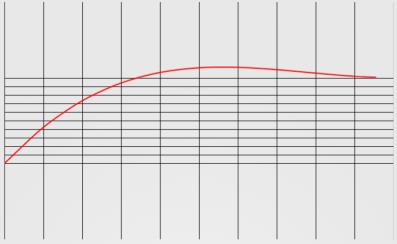
AnticipateOvershootInterpolator
源码:
/**
* An interpolator where the change starts backward then flings forward and overshoots
* the target value and finally goes back to the final value.
*/
public class AnticipateOvershootInterpolator implements Interpolator {
private final float mTension;
public AnticipateOvershootInterpolator() {
mTension = 2.0f * 1.5f;
}
/**
* @param tension Amount of anticipation/overshoot. When tension equals 0.0f,
* there is no anticipation/overshoot and the interpolator becomes
* a simple acceleration/deceleration interpolator.
*/
public AnticipateOvershootInterpolator(float tension) {
mTension = tension * 1.5f;
}
/**
* @param tension Amount of anticipation/overshoot. When tension equals 0.0f,
* there is no anticipation/overshoot and the interpolator becomes
* a simple acceleration/deceleration interpolator.
* @param extraTension Amount by which to multiply the tension. For instance,
* to get the same overshoot as an OvershootInterpolator with
* a tension of 2.0f, you would use an extraTension of 1.5f.
*/
public AnticipateOvershootInterpolator(float tension, float extraTension) {
mTension = tension * extraTension;
}
public AnticipateOvershootInterpolator(Context context, AttributeSet attrs) {
TypedArray a = context.obtainStyledAttributes(attrs, AnticipateOvershootInterpolator);
mTension = a.getFloat(AnticipateOvershootInterpolator_tension, 2.0f) *
a.getFloat(AnticipateOvershootInterpolator_extraTension, 1.5f);
a.recycle();
}
private static float a(float t, float s) {
return t * t * ((s + 1) * t - s);
}
private static float o(float t, float s) {
return t * t * ((s + 1) * t + s);
}
public float getInterpolation(float t) {
// a(t, s) = t * t * ((s + 1) * t - s)
// o(t, s) = t * t * ((s + 1) * t + s)
// f(t) = 0.5 * a(t * 2, tension * extraTension), when t < 0.5
// f(t) = 0.5 * (o(t * 2 - 2, tension * extraTension) + 2), when t <= 1.0
if (t < 0.5f) return 0.5f * a(t * 2.0f, mTension);
else return 0.5f * (o(t * 2.0f - 2.0f, mTension) + 2.0f);
}
}
曲线图:
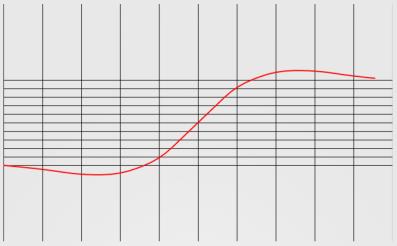
BounceInterpolator
源码:
/**
* An interpolator where the change bounces at the end.
*/
public class BounceInterpolator implements Interpolator {
public BounceInterpolator() {
}
@SuppressWarnings({"UnusedDeclaration"})
public BounceInterpolator(Context context, AttributeSet attrs) {
}
private static float bounce(float t) {
return t * t * 8.0f;
}
public float getInterpolation(float t) {
// _b(t) = t * t * 8
// bs(t) = _b(t) for t < 0.3535
// bs(t) = _b(t - 0.54719) + 0.7 for t < 0.7408
// bs(t) = _b(t - 0.8526) + 0.9 for t < 0.9644
// bs(t) = _b(t - 1.0435) + 0.95 for t <= 1.0
// b(t) = bs(t * 1.1226)
t *= 1.1226f;
if (t < 0.3535f) return bounce(t);
else if (t < 0.7408f) return bounce(t - 0.54719f) + 0.7f;
else if (t < 0.9644f) return bounce(t - 0.8526f) + 0.9f;
else return bounce(t - 1.0435f) + 0.95f;
}
}
曲线图:
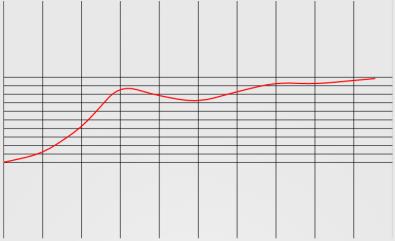
CycleInterpolator
源码:
/**
* Repeats the animation for a specified number of cycles. The
* rate of change follows a sinusoidal pattern.
*
*/
public class CycleInterpolator implements Interpolator {
public CycleInterpolator(float cycles) {
mCycles = cycles;
}
public CycleInterpolator(Context context, AttributeSet attrs) {
TypedArray a =
context.obtainStyledAttributes(attrs, com.android.internal.R.styleable.CycleInterpolator);
mCycles = a.getFloat(com.android.internal.R.styleable.CycleInterpolator_cycles, 1.0f);
a.recycle();
}
public float getInterpolation(float input) {
return (float)(Math.sin(2 * mCycles * Math.PI * input));
}
private float mCycles;
}
曲线图:
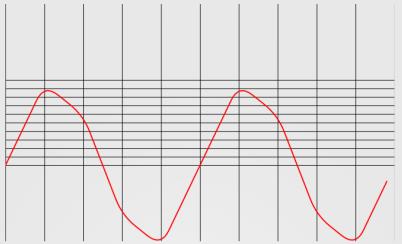
以上是关于Interpolator的种类的主要内容,如果未能解决你的问题,请参考以下文章